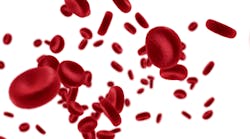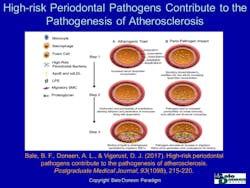Editor's note: Originally published February 20, 2018. Formatting updated November 10, 2022.
As a practicing dentist for more than 35 years, I have always taken interest in the overall health of my patients. For many years, I have intuitively felt that a healthy mouth correlates with overall general health. Observing my patients who have been with me for decades has confirmed this. Not surprisingly, the latest medical research keeps uncovering new facts that prove this to be true, and some of the most exciting scientific discoveries have linked oral health to cardiovascular health. Heart attacks and strokes have been proven to have many direct causes, such as obesity, insulin resistance, smoking, inflammatory disorders, and high cholesterol. Recently, dental infections were added to the list, including periodontal disease, abscessed teeth, and failing endodontics.1
An article published online in November 2016 by the Postgraduate Medical Journal and in its April 2017 issue—written by Bradley Bale, MD, and Amy Doneen, ARNP—demonstrates the pathways of specific bacteria from dental infections and how they directly cause heart attacks and strokes. Their article, "High-risk Periodontal Pathogens Contribute to the Pathogenesis of Atherosclerosis,"is a landmark publication that takes dental pathogens from an associated cause to a direct causal status of arteriosclerotic vascular disease (figure 1).1 From their research, the authors conclude that dentists now have the added responsibility of diagnosing and treating dental disease not only to help patients save their teeth and gums, but also potentially save their lives.
Inflammation is key
The common denominator for all the risk factors for cardiovascular disease (CVD) is chronic inflammation of the arteries. It is now understood that heart attacks and strokes are triggered when a diseased, plaque-filled artery becomes so inflamed that the vessel wall is breached. This leads to the creation of a clot that obstructs blood flow to the heart or brain.2 In simplified terms, this is now what is recognized as the cause of heart attacks and strokes. The prevention of these diseases mandates that the inflammatory processes are eliminated.
Dental infections have been proven to be caused by specific bacterial pathogens. Five of these pathogens have now been demonstrated to also cause heart attacks and strokes by being major players in creating inflammation within the arteries. It has been well-documented how these pathogens migrate into the arterial system.1 Very sophisticated studies have shown a strong similarity between the amount of inflammation of our gums and the amount of inflammation in the major arteries of the neck and aorta. Studies have also indicated how most plaque in the carotid artery contains many of the germs that cause periodontal disease.3
Endodontic pathogens cause CVD
A recent study published by Dr. Tanja Pessi and colleagues in the American Heart Association's journal, Circulation, demonstrates that endodontic failures and lesions also play a significant role in CVD. In a study of the clots and blood samples from 101 people in the throes of a heart attack, it was discovered that 78.2% percent of the clots had oral pathogens that cause these abscesses and 34.7% of the clots contained bacteria found in periodontal disease. X-rays from 30 of the patients found that 50% had infected teeth. Research findings suggest that up to 50% of heart attacks may be triggered by an infection in the mouth.4
Dr. Pessi’s studies—along with the clinical experiences of Bale and Doneen—help to prove that the oral-systemic connection is more significant than previously surmised. It is their belief that any patient who has suffered a heart attack or stroke deserves to be evaluated by a dentist who is knowledgeable in this area and who has the technical equipment necessary to properly diagnose these infections. As such, 3D cone beam radiography is a must to accurately detect failing root canals and teeth with infections that may not show up on 2D films.
Bale and Doneen documented how many of their patients' inflammatory markers were reduced after undergoing proper dental treatment for their oral infections. If inflammation was not present in the arteries, then patients were not at risk for a heart attack or stroke.2 Dentists have a significant role in the prevention of these deadly diseases by eliminating dental infections. The rationale for watching asymptomatic lesions will be questioned once dentists understand how important their role is in their patients' cardiovascular health.
Dentistry’s clinical role in CVD prevention
With this latest information, dentists will have an increased responsibility to inform patients that their lives may be at risk if they have infections of the teeth and gums. Family history of CVD must be noted as well as an understanding of the other risk factors that are easily detected by the use of a thorough health history questionnaire and patient interview.
Since it has been shown that dental pathogens cause CVD, dentists must to be able to treat dental diseases with verifiable antimicrobial therapies. Dentists must also provide DNA testing for the specific types of bacteria that are causal for heart attacks and strokes in their diagnoses as well as postoperatively for verification of treatment results.2 Currently, this can be done by companies that offer salivary testing for the various bacteria associated with periodontal disease and CVD (such as OralDNA Labs).
Once diagnosed, treatment protocols need to be directed toward the elimination of bacterial pathogens. Microbiological therapies to treat periodontal disease include antimicrobial irrigation and antibiotics in conjunction with scaling and root planing. The Millennium PerioLase laser, for example, has been demonstrated to significantly reduce bacterial pathogens with the LANAP protocol. Home care can include prescription mouthwashes and custom dental trays with antibacterial gels.
All heart attacks and strokes are potentially preventable with optimum medical and dental care, which includes correctly identifying and treating the root causes of patients' cardiovascular disease. Dentists can now have a major impact in the prevention of CVD. In their book Beat the Heart Attack Gene: The Revolutionary Plan to Prevent Heart Disease, Stroke, and Diabetes, authors Bale and Doneen outline a unique, proven methodology that can help millions live longer and healthier lives. Dentistry will soon be called upon to develop predictable microbiological therapies and protocols to do its part in fighting this disease.
The BaleDoneen Method for heart attack and stroke prevention is helping to lead the medical profession into an entirely new and exciting future of early diagnosis and preventive planning that will include dentists as a part of its interdisciplinary team. This book is an absolute must for all dentists, as it outlines how important these strategies can be to patients' cardiovascular health. I recommend it to all of my patients who have had strokes or heart attacks, or those patients whom I believe are at risk based on their health history, exams, or interviews.
Dentistry has been demonstrated to be a cornerstone in the treatment of arterial disease by Bale and Doneen,2 and as such, we have now been brought into the fold of diagnosing and treating one of the leading causes of morbidity. Our skills and technology have been exponentially elevated in worth and status. Our dental services, including basic prevention programs, not only can have the goal of healthy teeth and gums, but also the prevention of life-threatening diseases.
These two author/researchers have potentially initiated the beginnings of a new era for dentistry. When their new information becomes more mainstream, patients will likely have a greater appreciation of dental services with a higher acceptance of our treatment plans. We will be able to add new services to our treatment menus and create new profit centers as upgraded antimicrobial therapies and protocols are developed. Dentists will have the opportunity to become partners with physicians to treat and prevent CVD using new protocols in dental medicine.
References
1. Bale BF, Doneen AL, Vigerust DJ High-risk periodontal pathogens contribute to the pathogenesis of atherosclerosis. Postgrad Med J. 2017;93(1098)215-220. Published online 2016 doi:10.1136/postgradmedj-2016-134279
2. Bale B, Doneen A. Beat the Heart Attack Gene: The Revolutionary Plan to Prevent Heart Disease, Stroke, and Diabetes. Nashville, TN: Turner Publishing Co.; 2014.
3. Fifer, KM, Qadir S, Subramanian S, et al. Positron emission tomography measurement of periodontal 18F-fluorodeoxyglucose uptake is associated with histologically determined carotid plaque inflammation. J Am Coll Cardiol. 2011;57(8):971-976. doi:10.1016/j.jacc.2010.09.056
4. Pessi T, Karhunen V, Karjalainen PP, et al. Bacterial signatures in thrombosis aspirates of patients with myocardial infarction. Circulation. 2013;127(11):1219-1228. doi:10.1161/CIRCULATIONAHA.112.001254







